Detailed Report on Object Modelling and Design of Collin’s ATM System
VerifiedAdded on 2023/06/12
|15
|3032
|261
Report
AI Summary
This report provides a detailed analysis of the Collin's Bank ATM system using object modeling techniques. It outlines the functional and non-functional requirements of the ATM, including processes like card reading, PIN verification, transaction options (withdrawal, deposit, balance inquiry, etc.), and receipt printing. A use case diagram illustrates the interactions between customers and technicians with the ATM system, while a UML class diagram depicts the system's structure. The report also discusses the five key design activities of the Software Development Life Cycle (SDLC): planning, testing, deployment, implementation, and maintenance, highlighting the importance of environment, component design, user interfaces, database integration, and software methods in the development process. This analysis provides a comprehensive understanding of the design and development considerations for an ATM system.
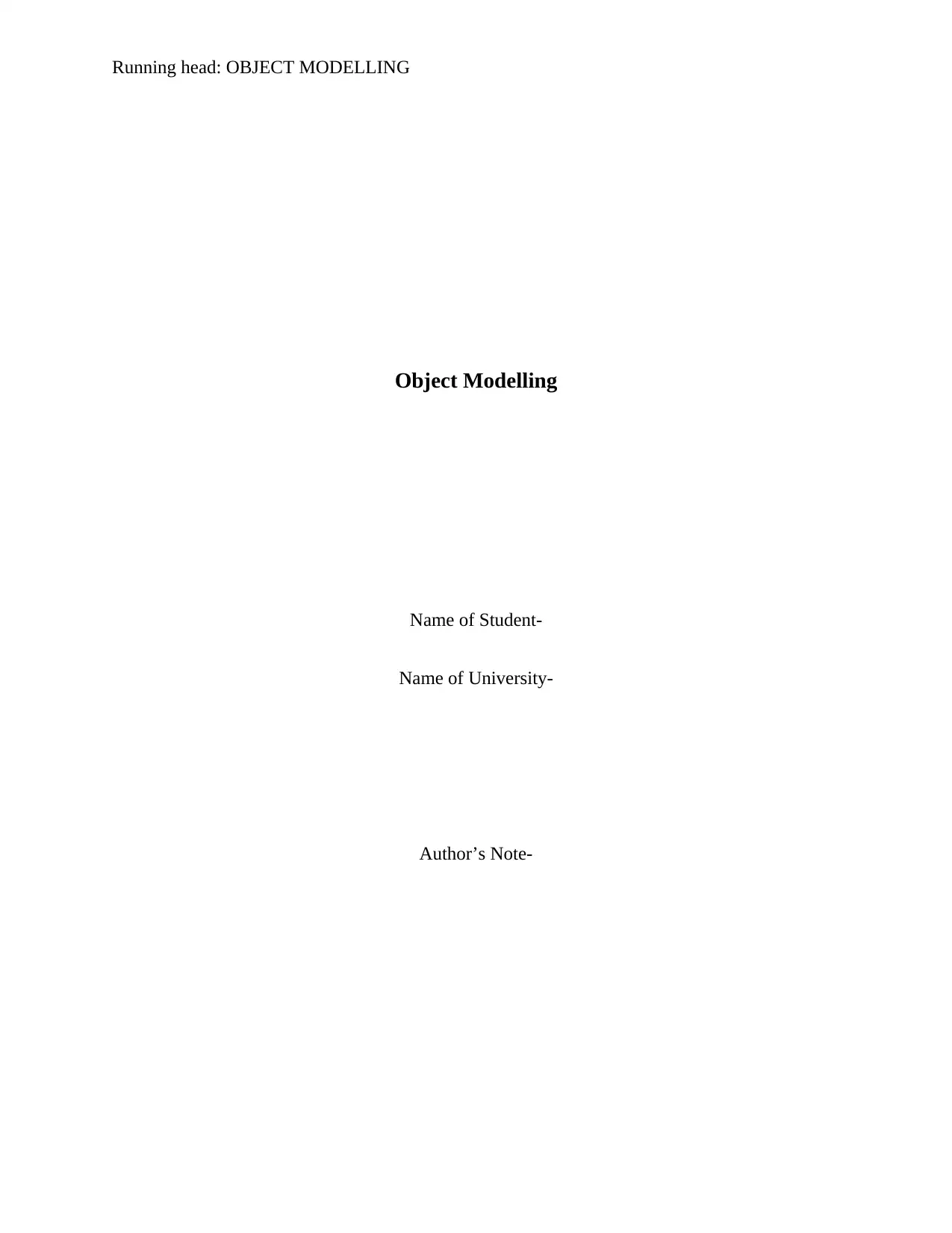
Running head: OBJECT MODELLING
Object Modelling
Name of Student-
Name of University-
Author’s Note-
Object Modelling
Name of Student-
Name of University-
Author’s Note-
Paraphrase This Document
Need a fresh take? Get an instant paraphrase of this document with our AI Paraphraser
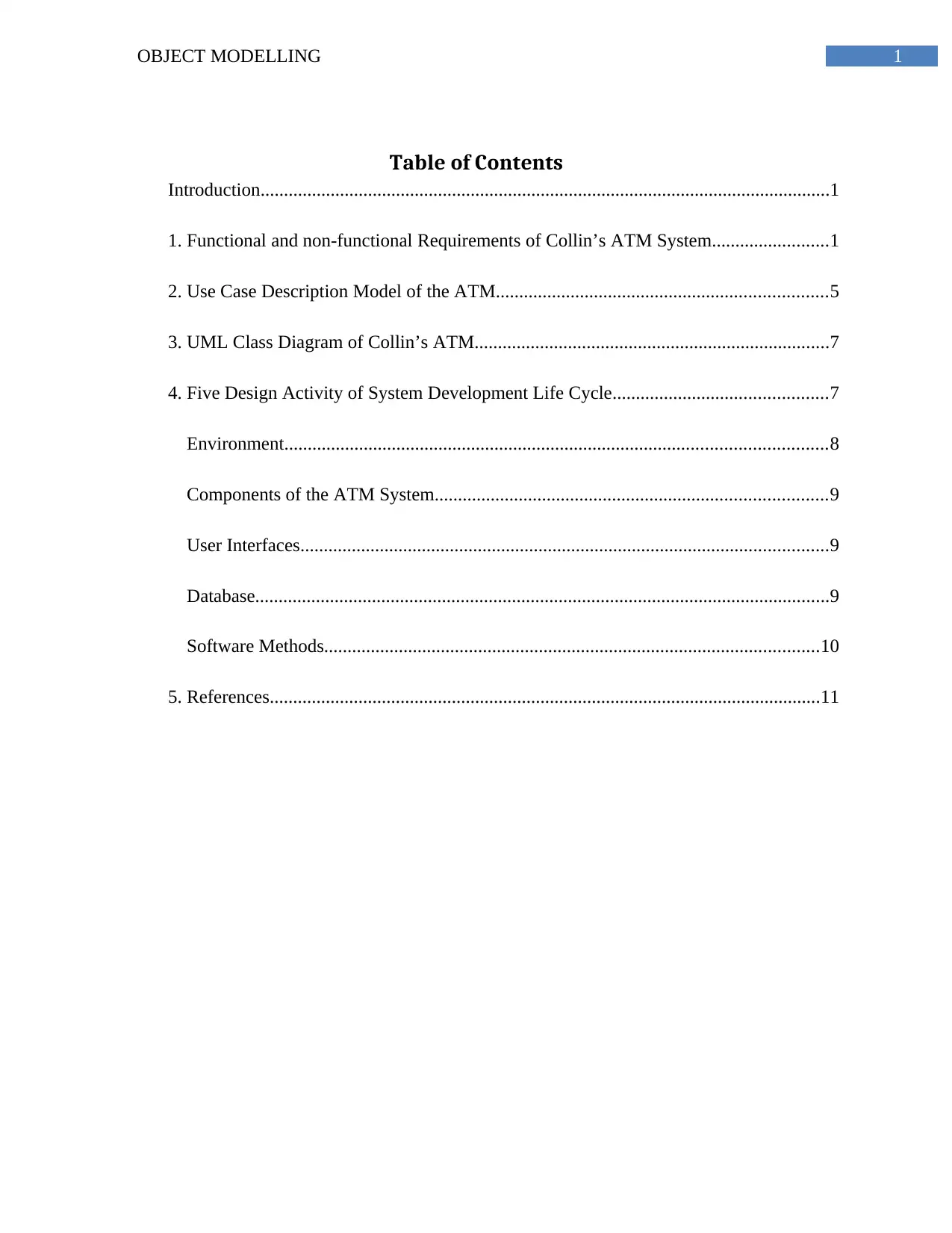
1OBJECT MODELLING
Table of Contents
Introduction..........................................................................................................................1
1. Functional and non-functional Requirements of Collin’s ATM System.........................1
2. Use Case Description Model of the ATM.......................................................................5
3. UML Class Diagram of Collin’s ATM............................................................................7
4. Five Design Activity of System Development Life Cycle..............................................7
Environment....................................................................................................................8
Components of the ATM System....................................................................................9
User Interfaces.................................................................................................................9
Database...........................................................................................................................9
Software Methods..........................................................................................................10
5. References......................................................................................................................11
Table of Contents
Introduction..........................................................................................................................1
1. Functional and non-functional Requirements of Collin’s ATM System.........................1
2. Use Case Description Model of the ATM.......................................................................5
3. UML Class Diagram of Collin’s ATM............................................................................7
4. Five Design Activity of System Development Life Cycle..............................................7
Environment....................................................................................................................8
Components of the ATM System....................................................................................9
User Interfaces.................................................................................................................9
Database...........................................................................................................................9
Software Methods..........................................................................................................10
5. References......................................................................................................................11
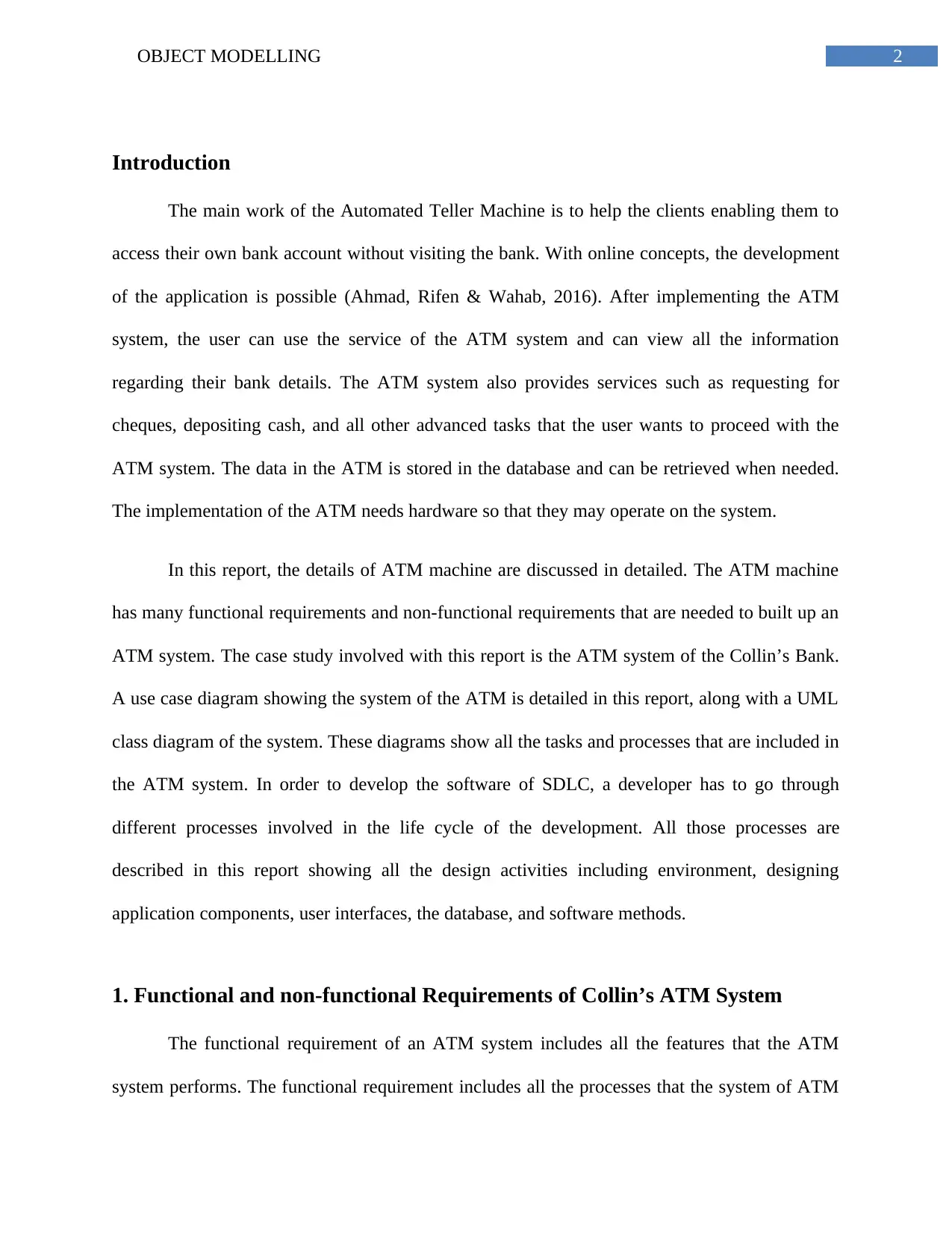
2OBJECT MODELLING
Introduction
The main work of the Automated Teller Machine is to help the clients enabling them to
access their own bank account without visiting the bank. With online concepts, the development
of the application is possible (Ahmad, Rifen & Wahab, 2016). After implementing the ATM
system, the user can use the service of the ATM system and can view all the information
regarding their bank details. The ATM system also provides services such as requesting for
cheques, depositing cash, and all other advanced tasks that the user wants to proceed with the
ATM system. The data in the ATM is stored in the database and can be retrieved when needed.
The implementation of the ATM needs hardware so that they may operate on the system.
In this report, the details of ATM machine are discussed in detailed. The ATM machine
has many functional requirements and non-functional requirements that are needed to built up an
ATM system. The case study involved with this report is the ATM system of the Collin’s Bank.
A use case diagram showing the system of the ATM is detailed in this report, along with a UML
class diagram of the system. These diagrams show all the tasks and processes that are included in
the ATM system. In order to develop the software of SDLC, a developer has to go through
different processes involved in the life cycle of the development. All those processes are
described in this report showing all the design activities including environment, designing
application components, user interfaces, the database, and software methods.
1. Functional and non-functional Requirements of Collin’s ATM System
The functional requirement of an ATM system includes all the features that the ATM
system performs. The functional requirement includes all the processes that the system of ATM
Introduction
The main work of the Automated Teller Machine is to help the clients enabling them to
access their own bank account without visiting the bank. With online concepts, the development
of the application is possible (Ahmad, Rifen & Wahab, 2016). After implementing the ATM
system, the user can use the service of the ATM system and can view all the information
regarding their bank details. The ATM system also provides services such as requesting for
cheques, depositing cash, and all other advanced tasks that the user wants to proceed with the
ATM system. The data in the ATM is stored in the database and can be retrieved when needed.
The implementation of the ATM needs hardware so that they may operate on the system.
In this report, the details of ATM machine are discussed in detailed. The ATM machine
has many functional requirements and non-functional requirements that are needed to built up an
ATM system. The case study involved with this report is the ATM system of the Collin’s Bank.
A use case diagram showing the system of the ATM is detailed in this report, along with a UML
class diagram of the system. These diagrams show all the tasks and processes that are included in
the ATM system. In order to develop the software of SDLC, a developer has to go through
different processes involved in the life cycle of the development. All those processes are
described in this report showing all the design activities including environment, designing
application components, user interfaces, the database, and software methods.
1. Functional and non-functional Requirements of Collin’s ATM System
The functional requirement of an ATM system includes all the features that the ATM
system performs. The functional requirement includes all the processes that the system of ATM
⊘ This is a preview!⊘
Do you want full access?
Subscribe today to unlock all pages.

Trusted by 1+ million students worldwide
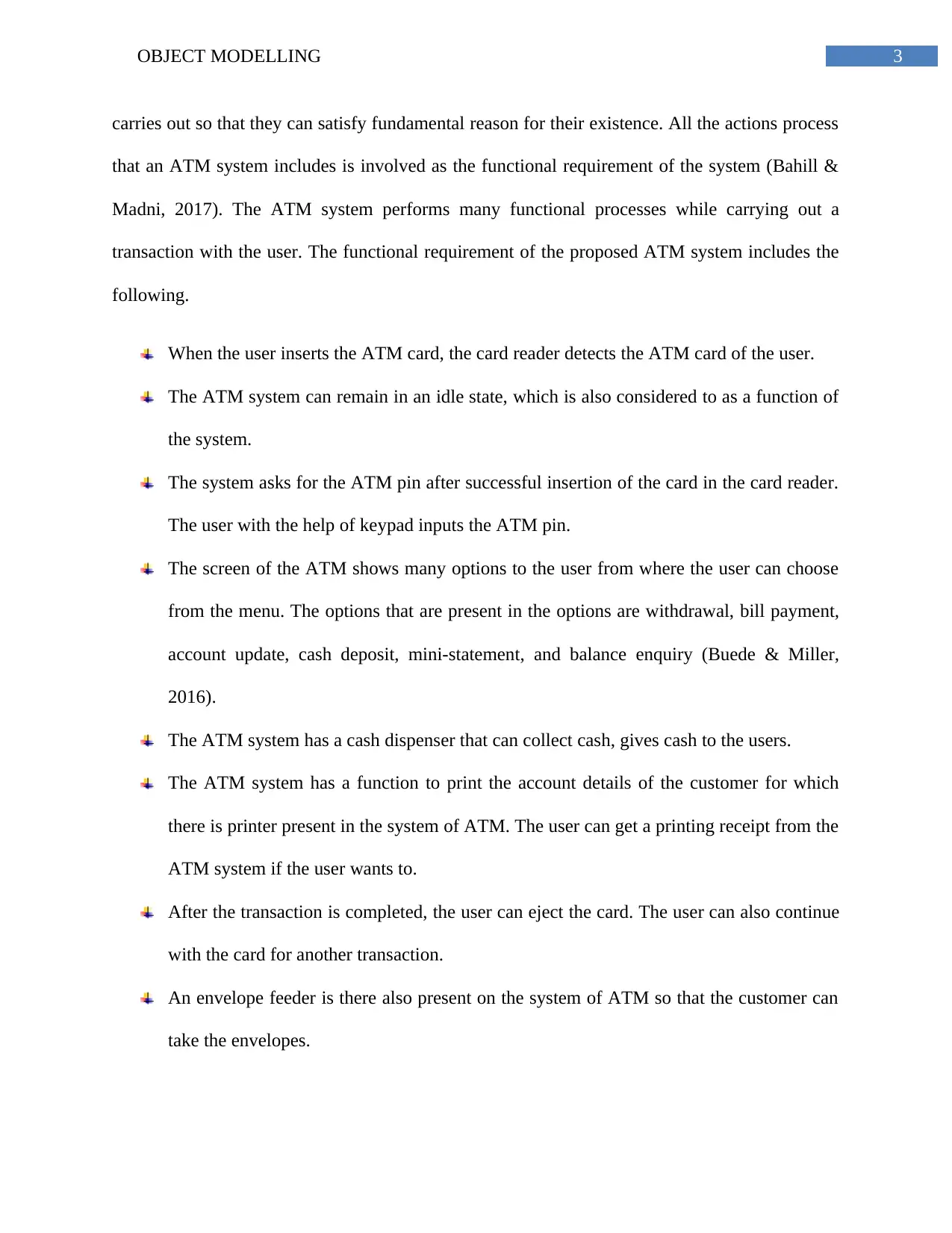
3OBJECT MODELLING
carries out so that they can satisfy fundamental reason for their existence. All the actions process
that an ATM system includes is involved as the functional requirement of the system (Bahill &
Madni, 2017). The ATM system performs many functional processes while carrying out a
transaction with the user. The functional requirement of the proposed ATM system includes the
following.
When the user inserts the ATM card, the card reader detects the ATM card of the user.
The ATM system can remain in an idle state, which is also considered to as a function of
the system.
The system asks for the ATM pin after successful insertion of the card in the card reader.
The user with the help of keypad inputs the ATM pin.
The screen of the ATM shows many options to the user from where the user can choose
from the menu. The options that are present in the options are withdrawal, bill payment,
account update, cash deposit, mini-statement, and balance enquiry (Buede & Miller,
2016).
The ATM system has a cash dispenser that can collect cash, gives cash to the users.
The ATM system has a function to print the account details of the customer for which
there is printer present in the system of ATM. The user can get a printing receipt from the
ATM system if the user wants to.
After the transaction is completed, the user can eject the card. The user can also continue
with the card for another transaction.
An envelope feeder is there also present on the system of ATM so that the customer can
take the envelopes.
carries out so that they can satisfy fundamental reason for their existence. All the actions process
that an ATM system includes is involved as the functional requirement of the system (Bahill &
Madni, 2017). The ATM system performs many functional processes while carrying out a
transaction with the user. The functional requirement of the proposed ATM system includes the
following.
When the user inserts the ATM card, the card reader detects the ATM card of the user.
The ATM system can remain in an idle state, which is also considered to as a function of
the system.
The system asks for the ATM pin after successful insertion of the card in the card reader.
The user with the help of keypad inputs the ATM pin.
The screen of the ATM shows many options to the user from where the user can choose
from the menu. The options that are present in the options are withdrawal, bill payment,
account update, cash deposit, mini-statement, and balance enquiry (Buede & Miller,
2016).
The ATM system has a cash dispenser that can collect cash, gives cash to the users.
The ATM system has a function to print the account details of the customer for which
there is printer present in the system of ATM. The user can get a printing receipt from the
ATM system if the user wants to.
After the transaction is completed, the user can eject the card. The user can also continue
with the card for another transaction.
An envelope feeder is there also present on the system of ATM so that the customer can
take the envelopes.
Paraphrase This Document
Need a fresh take? Get an instant paraphrase of this document with our AI Paraphraser
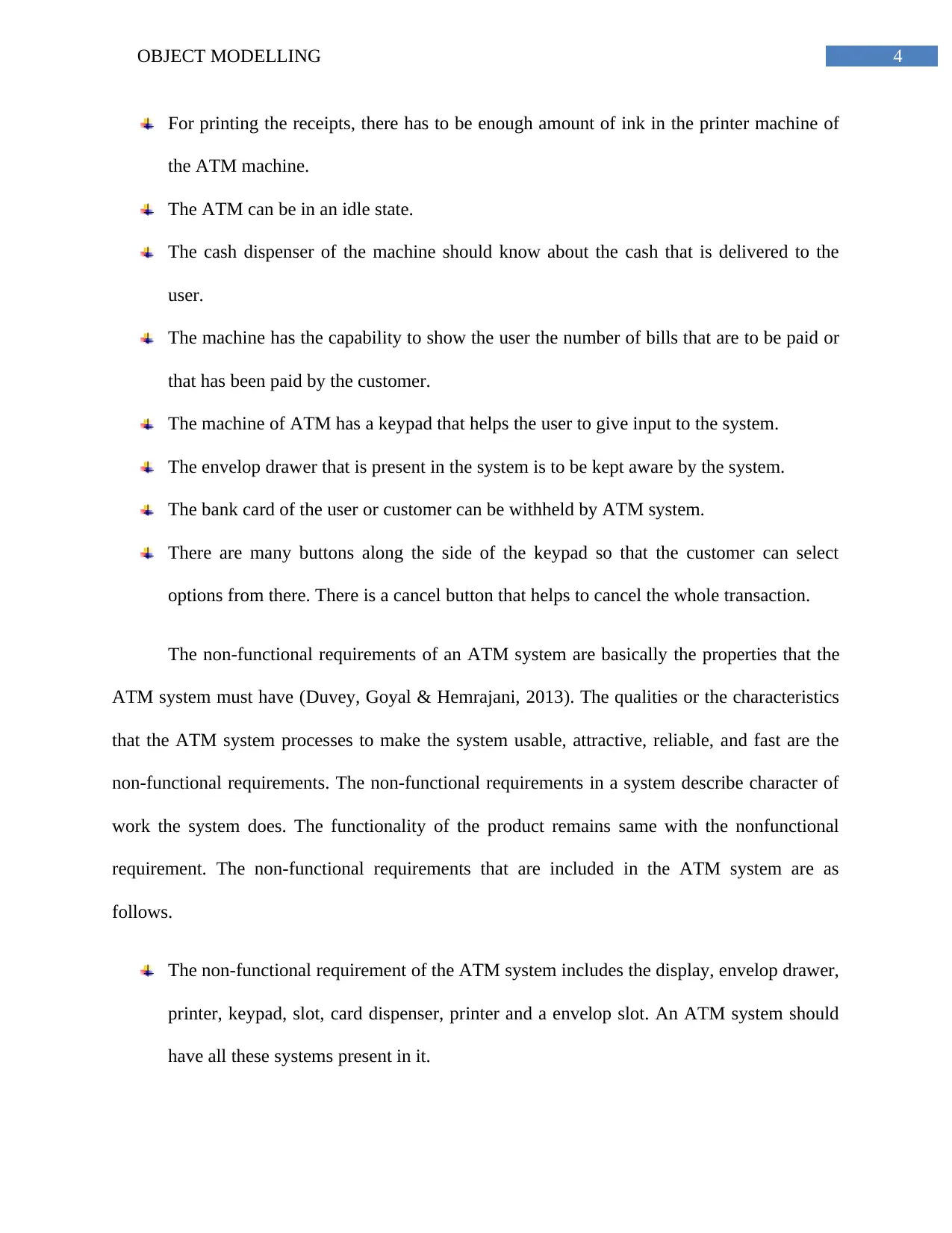
4OBJECT MODELLING
For printing the receipts, there has to be enough amount of ink in the printer machine of
the ATM machine.
The ATM can be in an idle state.
The cash dispenser of the machine should know about the cash that is delivered to the
user.
The machine has the capability to show the user the number of bills that are to be paid or
that has been paid by the customer.
The machine of ATM has a keypad that helps the user to give input to the system.
The envelop drawer that is present in the system is to be kept aware by the system.
The bank card of the user or customer can be withheld by ATM system.
There are many buttons along the side of the keypad so that the customer can select
options from there. There is a cancel button that helps to cancel the whole transaction.
The non-functional requirements of an ATM system are basically the properties that the
ATM system must have (Duvey, Goyal & Hemrajani, 2013). The qualities or the characteristics
that the ATM system processes to make the system usable, attractive, reliable, and fast are the
non-functional requirements. The non-functional requirements in a system describe character of
work the system does. The functionality of the product remains same with the nonfunctional
requirement. The non-functional requirements that are included in the ATM system are as
follows.
The non-functional requirement of the ATM system includes the display, envelop drawer,
printer, keypad, slot, card dispenser, printer and a envelop slot. An ATM system should
have all these systems present in it.
For printing the receipts, there has to be enough amount of ink in the printer machine of
the ATM machine.
The ATM can be in an idle state.
The cash dispenser of the machine should know about the cash that is delivered to the
user.
The machine has the capability to show the user the number of bills that are to be paid or
that has been paid by the customer.
The machine of ATM has a keypad that helps the user to give input to the system.
The envelop drawer that is present in the system is to be kept aware by the system.
The bank card of the user or customer can be withheld by ATM system.
There are many buttons along the side of the keypad so that the customer can select
options from there. There is a cancel button that helps to cancel the whole transaction.
The non-functional requirements of an ATM system are basically the properties that the
ATM system must have (Duvey, Goyal & Hemrajani, 2013). The qualities or the characteristics
that the ATM system processes to make the system usable, attractive, reliable, and fast are the
non-functional requirements. The non-functional requirements in a system describe character of
work the system does. The functionality of the product remains same with the nonfunctional
requirement. The non-functional requirements that are included in the ATM system are as
follows.
The non-functional requirement of the ATM system includes the display, envelop drawer,
printer, keypad, slot, card dispenser, printer and a envelop slot. An ATM system should
have all these systems present in it.
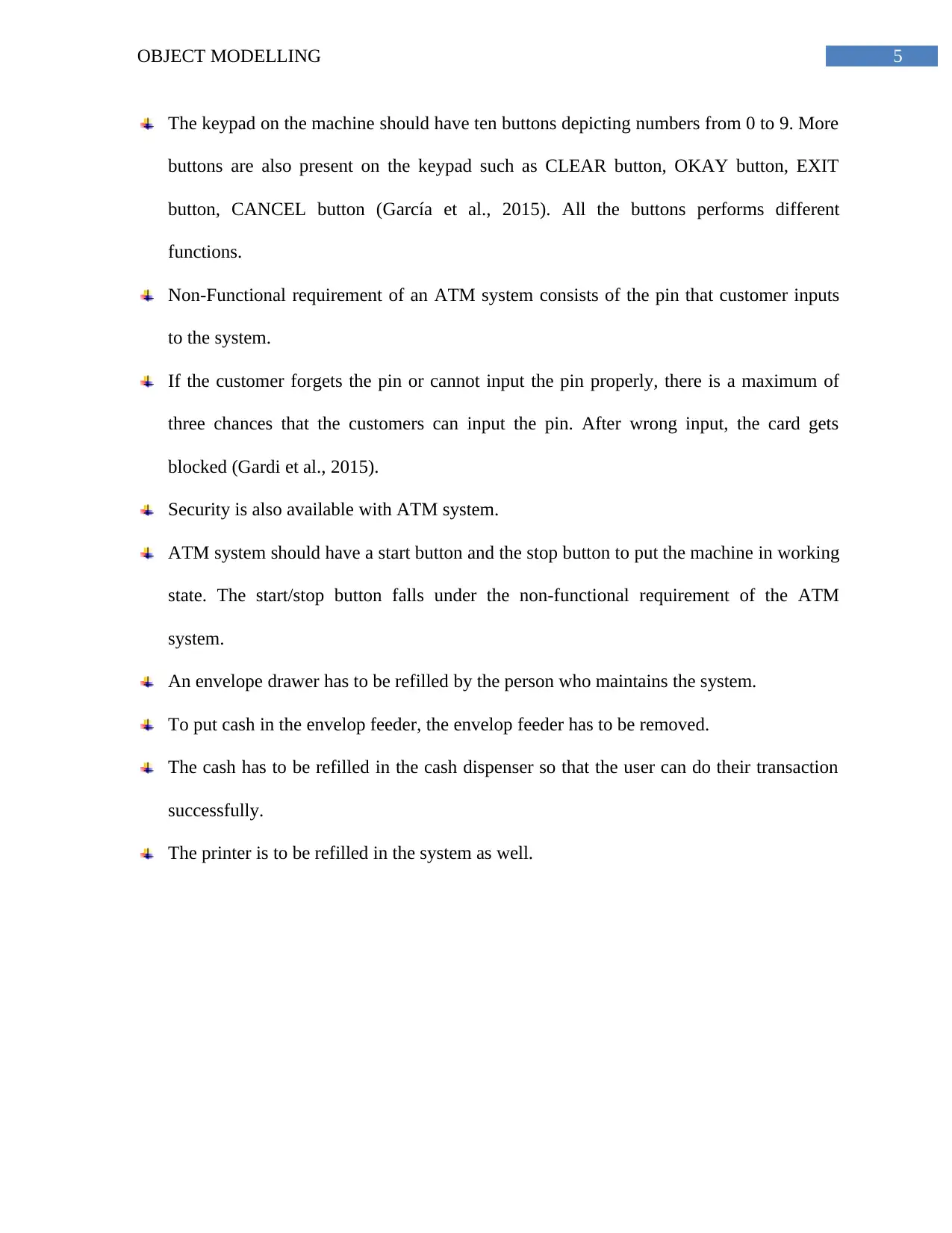
5OBJECT MODELLING
The keypad on the machine should have ten buttons depicting numbers from 0 to 9. More
buttons are also present on the keypad such as CLEAR button, OKAY button, EXIT
button, CANCEL button (García et al., 2015). All the buttons performs different
functions.
Non-Functional requirement of an ATM system consists of the pin that customer inputs
to the system.
If the customer forgets the pin or cannot input the pin properly, there is a maximum of
three chances that the customers can input the pin. After wrong input, the card gets
blocked (Gardi et al., 2015).
Security is also available with ATM system.
ATM system should have a start button and the stop button to put the machine in working
state. The start/stop button falls under the non-functional requirement of the ATM
system.
An envelope drawer has to be refilled by the person who maintains the system.
To put cash in the envelop feeder, the envelop feeder has to be removed.
The cash has to be refilled in the cash dispenser so that the user can do their transaction
successfully.
The printer is to be refilled in the system as well.
The keypad on the machine should have ten buttons depicting numbers from 0 to 9. More
buttons are also present on the keypad such as CLEAR button, OKAY button, EXIT
button, CANCEL button (García et al., 2015). All the buttons performs different
functions.
Non-Functional requirement of an ATM system consists of the pin that customer inputs
to the system.
If the customer forgets the pin or cannot input the pin properly, there is a maximum of
three chances that the customers can input the pin. After wrong input, the card gets
blocked (Gardi et al., 2015).
Security is also available with ATM system.
ATM system should have a start button and the stop button to put the machine in working
state. The start/stop button falls under the non-functional requirement of the ATM
system.
An envelope drawer has to be refilled by the person who maintains the system.
To put cash in the envelop feeder, the envelop feeder has to be removed.
The cash has to be refilled in the cash dispenser so that the user can do their transaction
successfully.
The printer is to be refilled in the system as well.
⊘ This is a preview!⊘
Do you want full access?
Subscribe today to unlock all pages.

Trusted by 1+ million students worldwide
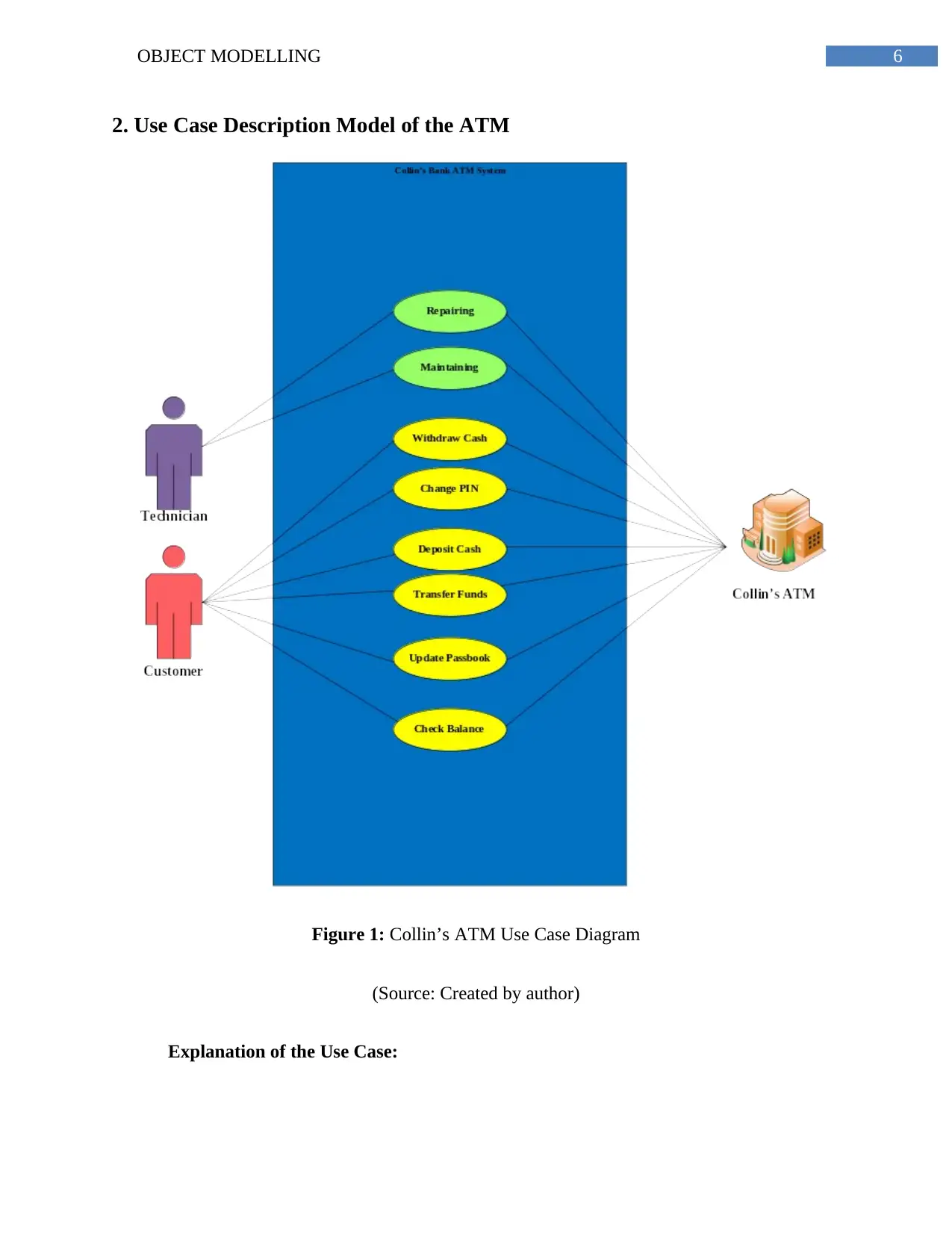
6OBJECT MODELLING
2. Use Case Description Model of the ATM
Figure 1: Collin’s ATM Use Case Diagram
(Source: Created by author)
Explanation of the Use Case:
2. Use Case Description Model of the ATM
Figure 1: Collin’s ATM Use Case Diagram
(Source: Created by author)
Explanation of the Use Case:
Paraphrase This Document
Need a fresh take? Get an instant paraphrase of this document with our AI Paraphraser
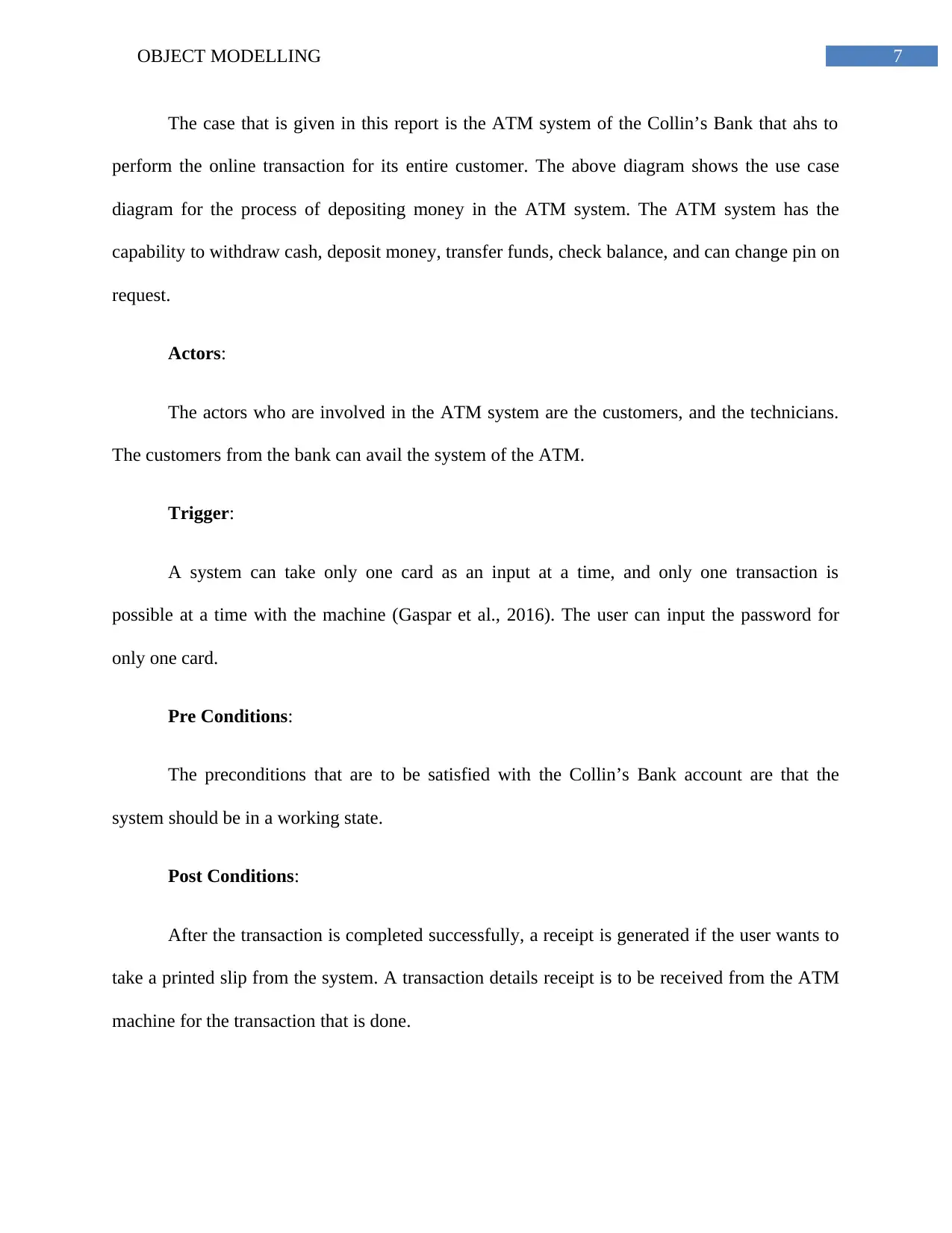
7OBJECT MODELLING
The case that is given in this report is the ATM system of the Collin’s Bank that ahs to
perform the online transaction for its entire customer. The above diagram shows the use case
diagram for the process of depositing money in the ATM system. The ATM system has the
capability to withdraw cash, deposit money, transfer funds, check balance, and can change pin on
request.
Actors:
The actors who are involved in the ATM system are the customers, and the technicians.
The customers from the bank can avail the system of the ATM.
Trigger:
A system can take only one card as an input at a time, and only one transaction is
possible at a time with the machine (Gaspar et al., 2016). The user can input the password for
only one card.
Pre Conditions:
The preconditions that are to be satisfied with the Collin’s Bank account are that the
system should be in a working state.
Post Conditions:
After the transaction is completed successfully, a receipt is generated if the user wants to
take a printed slip from the system. A transaction details receipt is to be received from the ATM
machine for the transaction that is done.
The case that is given in this report is the ATM system of the Collin’s Bank that ahs to
perform the online transaction for its entire customer. The above diagram shows the use case
diagram for the process of depositing money in the ATM system. The ATM system has the
capability to withdraw cash, deposit money, transfer funds, check balance, and can change pin on
request.
Actors:
The actors who are involved in the ATM system are the customers, and the technicians.
The customers from the bank can avail the system of the ATM.
Trigger:
A system can take only one card as an input at a time, and only one transaction is
possible at a time with the machine (Gaspar et al., 2016). The user can input the password for
only one card.
Pre Conditions:
The preconditions that are to be satisfied with the Collin’s Bank account are that the
system should be in a working state.
Post Conditions:
After the transaction is completed successfully, a receipt is generated if the user wants to
take a printed slip from the system. A transaction details receipt is to be received from the ATM
machine for the transaction that is done.
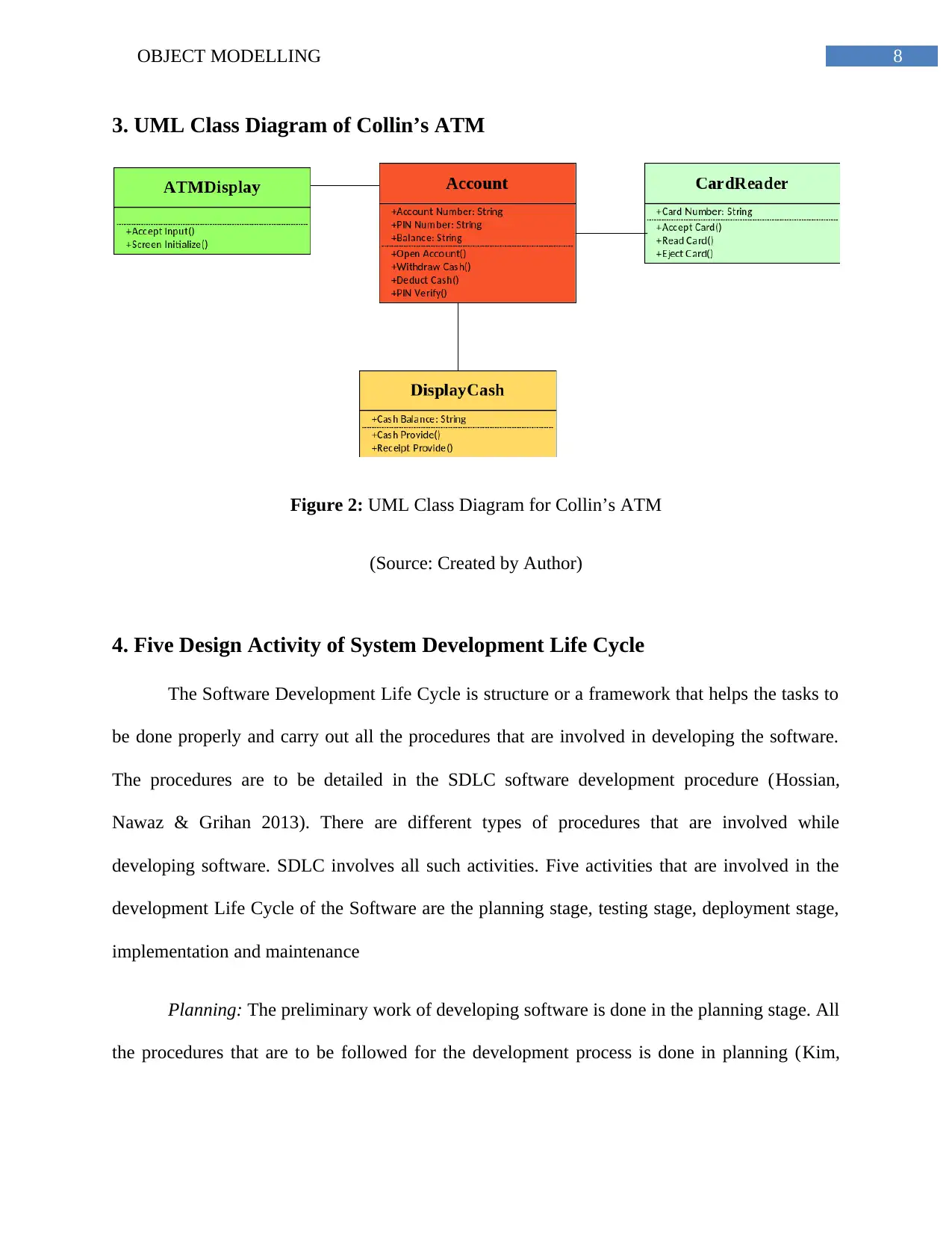
8OBJECT MODELLING
3. UML Class Diagram of Collin’s ATM
Figure 2: UML Class Diagram for Collin’s ATM
(Source: Created by Author)
4. Five Design Activity of System Development Life Cycle
The Software Development Life Cycle is structure or a framework that helps the tasks to
be done properly and carry out all the procedures that are involved in developing the software.
The procedures are to be detailed in the SDLC software development procedure (Hossian,
Nawaz & Grihan 2013). There are different types of procedures that are involved while
developing software. SDLC involves all such activities. Five activities that are involved in the
development Life Cycle of the Software are the planning stage, testing stage, deployment stage,
implementation and maintenance
Planning: The preliminary work of developing software is done in the planning stage. All
the procedures that are to be followed for the development process is done in planning (Kim,
3. UML Class Diagram of Collin’s ATM
Figure 2: UML Class Diagram for Collin’s ATM
(Source: Created by Author)
4. Five Design Activity of System Development Life Cycle
The Software Development Life Cycle is structure or a framework that helps the tasks to
be done properly and carry out all the procedures that are involved in developing the software.
The procedures are to be detailed in the SDLC software development procedure (Hossian,
Nawaz & Grihan 2013). There are different types of procedures that are involved while
developing software. SDLC involves all such activities. Five activities that are involved in the
development Life Cycle of the Software are the planning stage, testing stage, deployment stage,
implementation and maintenance
Planning: The preliminary work of developing software is done in the planning stage. All
the procedures that are to be followed for the development process is done in planning (Kim,
⊘ This is a preview!⊘
Do you want full access?
Subscribe today to unlock all pages.

Trusted by 1+ million students worldwide
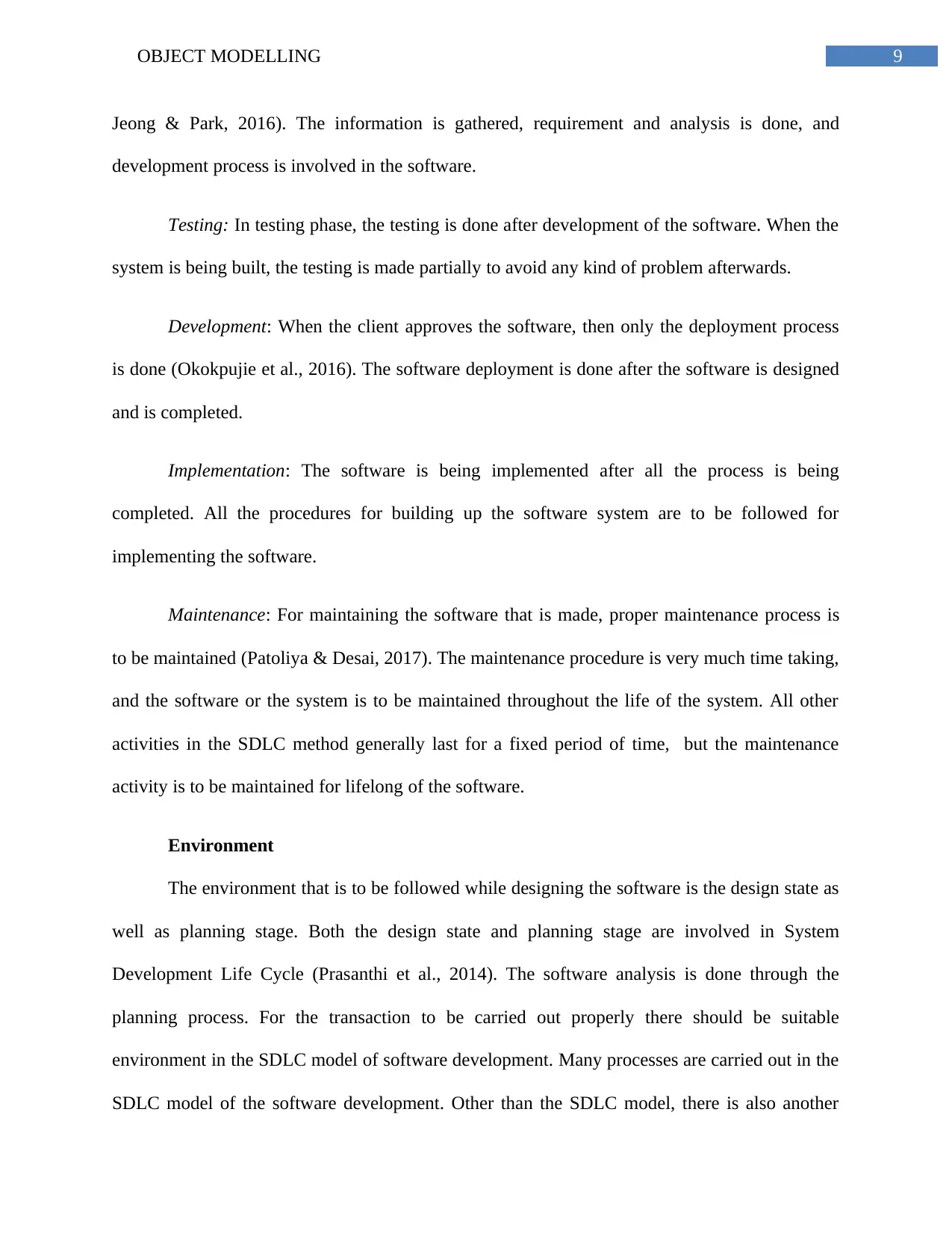
9OBJECT MODELLING
Jeong & Park, 2016). The information is gathered, requirement and analysis is done, and
development process is involved in the software.
Testing: In testing phase, the testing is done after development of the software. When the
system is being built, the testing is made partially to avoid any kind of problem afterwards.
Development: When the client approves the software, then only the deployment process
is done (Okokpujie et al., 2016). The software deployment is done after the software is designed
and is completed.
Implementation: The software is being implemented after all the process is being
completed. All the procedures for building up the software system are to be followed for
implementing the software.
Maintenance: For maintaining the software that is made, proper maintenance process is
to be maintained (Patoliya & Desai, 2017). The maintenance procedure is very much time taking,
and the software or the system is to be maintained throughout the life of the system. All other
activities in the SDLC method generally last for a fixed period of time, but the maintenance
activity is to be maintained for lifelong of the software.
Environment
The environment that is to be followed while designing the software is the design state as
well as planning stage. Both the design state and planning stage are involved in System
Development Life Cycle (Prasanthi et al., 2014). The software analysis is done through the
planning process. For the transaction to be carried out properly there should be suitable
environment in the SDLC model of software development. Many processes are carried out in the
SDLC model of the software development. Other than the SDLC model, there is also another
Jeong & Park, 2016). The information is gathered, requirement and analysis is done, and
development process is involved in the software.
Testing: In testing phase, the testing is done after development of the software. When the
system is being built, the testing is made partially to avoid any kind of problem afterwards.
Development: When the client approves the software, then only the deployment process
is done (Okokpujie et al., 2016). The software deployment is done after the software is designed
and is completed.
Implementation: The software is being implemented after all the process is being
completed. All the procedures for building up the software system are to be followed for
implementing the software.
Maintenance: For maintaining the software that is made, proper maintenance process is
to be maintained (Patoliya & Desai, 2017). The maintenance procedure is very much time taking,
and the software or the system is to be maintained throughout the life of the system. All other
activities in the SDLC method generally last for a fixed period of time, but the maintenance
activity is to be maintained for lifelong of the software.
Environment
The environment that is to be followed while designing the software is the design state as
well as planning stage. Both the design state and planning stage are involved in System
Development Life Cycle (Prasanthi et al., 2014). The software analysis is done through the
planning process. For the transaction to be carried out properly there should be suitable
environment in the SDLC model of software development. Many processes are carried out in the
SDLC model of the software development. Other than the SDLC model, there is also another
Paraphrase This Document
Need a fresh take? Get an instant paraphrase of this document with our AI Paraphraser
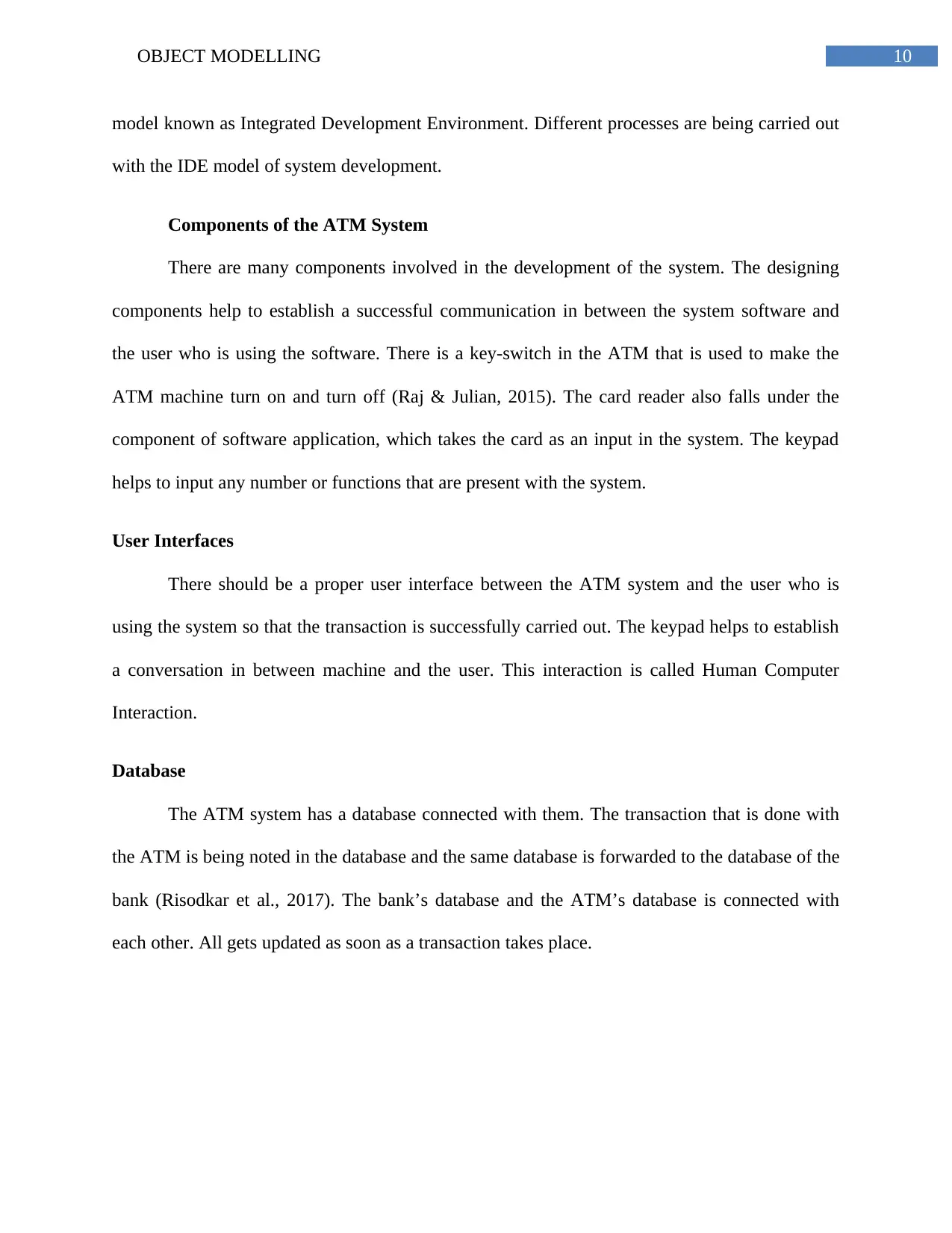
10OBJECT MODELLING
model known as Integrated Development Environment. Different processes are being carried out
with the IDE model of system development.
Components of the ATM System
There are many components involved in the development of the system. The designing
components help to establish a successful communication in between the system software and
the user who is using the software. There is a key-switch in the ATM that is used to make the
ATM machine turn on and turn off (Raj & Julian, 2015). The card reader also falls under the
component of software application, which takes the card as an input in the system. The keypad
helps to input any number or functions that are present with the system.
User Interfaces
There should be a proper user interface between the ATM system and the user who is
using the system so that the transaction is successfully carried out. The keypad helps to establish
a conversation in between machine and the user. This interaction is called Human Computer
Interaction.
Database
The ATM system has a database connected with them. The transaction that is done with
the ATM is being noted in the database and the same database is forwarded to the database of the
bank (Risodkar et al., 2017). The bank’s database and the ATM’s database is connected with
each other. All gets updated as soon as a transaction takes place.
model known as Integrated Development Environment. Different processes are being carried out
with the IDE model of system development.
Components of the ATM System
There are many components involved in the development of the system. The designing
components help to establish a successful communication in between the system software and
the user who is using the software. There is a key-switch in the ATM that is used to make the
ATM machine turn on and turn off (Raj & Julian, 2015). The card reader also falls under the
component of software application, which takes the card as an input in the system. The keypad
helps to input any number or functions that are present with the system.
User Interfaces
There should be a proper user interface between the ATM system and the user who is
using the system so that the transaction is successfully carried out. The keypad helps to establish
a conversation in between machine and the user. This interaction is called Human Computer
Interaction.
Database
The ATM system has a database connected with them. The transaction that is done with
the ATM is being noted in the database and the same database is forwarded to the database of the
bank (Risodkar et al., 2017). The bank’s database and the ATM’s database is connected with
each other. All gets updated as soon as a transaction takes place.

11OBJECT MODELLING
Software Methods
Different banks follow different software for the transaction. The software that is used for
carrying out the transaction process has different kinds of resources involved in it. The database
of the software that is to be used is Oracle for storing all the information.
Software Methods
Different banks follow different software for the transaction. The software that is used for
carrying out the transaction process has different kinds of resources involved in it. The database
of the software that is to be used is Oracle for storing all the information.
⊘ This is a preview!⊘
Do you want full access?
Subscribe today to unlock all pages.

Trusted by 1+ million students worldwide
1 out of 15
Related Documents
Your All-in-One AI-Powered Toolkit for Academic Success.
+13062052269
info@desklib.com
Available 24*7 on WhatsApp / Email
![[object Object]](/_next/static/media/star-bottom.7253800d.svg)
Unlock your academic potential
Copyright © 2020–2025 A2Z Services. All Rights Reserved. Developed and managed by ZUCOL.



